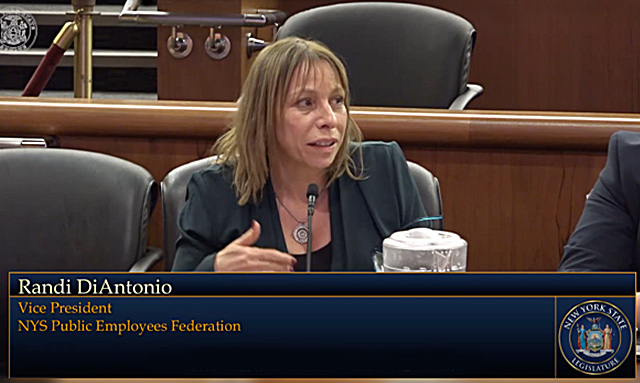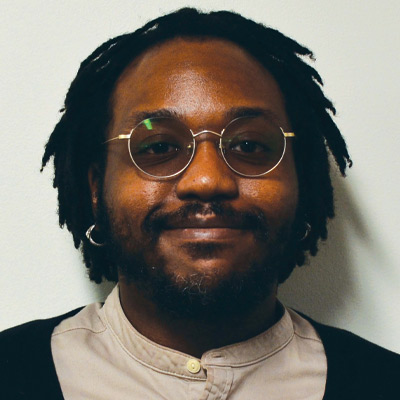
February 1, 2024 — During a joint legislative hearing on Workforce Development and Labor issues held on January 30 in Albany, PEF Vice President Randi DiAntonio presented lawmakers with viable solutions to the staffing shortages impacting every state agency.
DiAntonio thanked the Governor and the legislature for recent civil service reforms and for the proposals in this year’s executive budget to address ending the Lag Payroll and Salary Withholding Program. They are both steps that could help the state hire more staff to fill more than 11,000 vacancies.
“The challenge we face is that the state remains unable to attract and retain the staff it needs to deliver services,” DiAntonio told the panel. “This is evidenced by the continued closure of group homes across the state at OPWDD, the proposed closure of state correctional facilities without a clear plan and in a quick fashion, the challenges around wage theft and enforcement responsibilities, and the fact that state employees worked 22 million hours of overtime at a cost of $1.35 billion in 2022.”
According to a report from the Comptroller, the state lost 10,000 staff in 2022 — an increase of more than 40% since 2020 — all due to attrition, not retirement.
DiAntonio asked the legislative body to consider common-sense solutions to help. While PEF awaits the results of a Civil Service study of all titles in an effort to make public service jobs more competitive with the private sector, the union believes that fixing Tier 6 of the pension plan, cleaning up toxic workplace cultures, and ending the decentralization of human resources functions in the State, will help.
Tier 6 is one of the top priorities for PEF and many other unions. A rock-solid pension was once a massive incentive to pursue a career in the public sector and it can be again. PEF believes that there is sufficient funding to improve Tier 6 based on the fact that the State spent more than $1 billion on overtime in 2022 and annually spends another $1 billion on outside consulting contracts for work that PEF members can perform. PEF testified that the state needs to consider reducing employee pension contributions; reducing the final average salary calculation to 3 years versus the current 5 years; increasing the pension factor to 2% at 20 years; and adding a retirement option at age 55 when employees have 30 or more years of service.
On the compensation front, PEF is not waiting for the results of the Civil Service study to advocate for salary reallocations and restructuring for certain titles.
“Studies are great, but they take too long, people aren’t going to wait for them,” DiAntonio said.
She focused on social workers, tax auditors and open positions at the Department of Labor in her testimony, especially when it comes to making sure positions are offered a competitive salary.
“We have many titles that have advanced degrees where the private sector pays a lot more,” she said. “The balance used to be the pension and the healthcare benefits. As those things have diminished, we cannot compete.”
At the Department of Labor, there has been a drop of about 21% of the workforce, with many leaving due to low pay. Legislators concerned about the costs of paying to bolster the workforce, DiAntonio said, need only look at their own legislation.
“We know there is legislation that has been put forward to create a mechanism to fund the DOL by making sure we find those bad actors,” she said. “Let’s make sure those fines that are levied are returned to the DOL to fund wage enforcement.”
Even with the implementation of the HELPS program implemented by the Department of Civil Service and the successful hiring of 7,000 new state employees, retention remains an issue. Many PEF members are tempted to seek employment elsewhere when they see their agencies unable to efficiently serve New Yorkers due to staffing shortages.
“With the onset of telehealth and tele-med, many medical professionals can not only work elsewhere, they can be paid higher amounts of money, they can remote work,” DiAntonio said. “There’s all sorts of options that the state hasn’t really pursued as much.”
DiAntonio also called on legislators to consider not only investments into workers, but the places they work. It is important to PEF members that they have a safe place to work, and that includes the actual infrastructure.
“The physical buildings where people work are, in many cases, unsafe and falling apart,” she said.
As her testimony wrapped up, DiAntonio offered one last critical common-sense solution: Reform the hiring system itself. Even if the State fixes Tier 6, increases all salary grades, and reinvests in its workforce, New York’s hiring process is too slow.
“By the time someone gets information about a position, takes an exam, gets called back and offered a position, they’ve already found three other jobs,” she said. “The HELP program to us is a temporary stop gap. It is not the answer to all our problems.”
The answer, PEF believes, is paying public employees close to on-par with what they can make in the private sector, coupled with an attractive pension, solid benefits, and a good work-life balance. That was a formula that worked in the past and the union believes it can again if State lawmakers are willing to make the necessary changes.
Stay up to date on PEF Legislative Testimony on our PAC page
Send an email to your local lawmaker supporting PEF priorities
Watch PEF Vice President Randi DiAntonio’s testimony starting at about 2:31:20.

